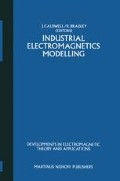Abstract
This paper describes how Langrangian and spline methods are used in high-order boundary element method (BEM) codes. These methodologies permit high-fidelity modelling of both source distributions and surfaces and yield improved efficiency and accuracy. A brief description of a new BEM program is included.
Access this chapter
Tax calculation will be finalised at checkout
Purchases are for personal use only
Preview
Unable to display preview. Download preview PDF.
References
Barsky, B.A. and Greenberg, D.P., “Determining a set of B-spline control vertices to generate an interpolating surface,” Computer Graphics and Image Processing, Vol. 14, pp. 203–226 (1980).
Bi1gen, S. and Wexler, A., “Spline boundary element solution of dielectric scattering problems,” Proceedings, 12th European Microwave Conference, Microwave Exhibitions and Publishers Ltd., Tunbridge Wells, England, pp. 371–377 (1982).
Bilgen, S., Cubic Spline Elements for Boundary Integral Equations. Ph.D. dissertation, Report TR82–5, Department of Electrical Engineering, University of Manitoba, Winnipeg (1982).
Cruse, T.A., “An improved boundary-integral equation method for three-dimensional e1as tic stress analysis”, Computers and Struc t., Vol. 4, pp. 741–754 (1974).
Jaswon, M.A. and Symm, G.T., Integral Equation Methods in Potential Theory and Elastostatics. Academic Press, London (1977)
Jeng, G. and Wexler, A., “Finite-element solution of boundary integral equations,” in Proc. Int. Symp. Large Engng Systems (Ed. A. Wexler), Pergamon Press, Oxford, pp. 112–121 (1977).
Jeng, G. and Wexler, A., “Isoparame tric, fini te element, variational solution of integral equations for three-dimensional fields,” Int. J. Num. Meth. Engng, Vol. 11, pp. 1455–1471 (1977).
Klimpke, B.W., A Two-Dimensional, Multi-Media Boundary Element Method. M.Sc. dissertation, Report TR83–2, Department of Electrical Engineering, University of Manitoba, Winnipeg. (1983).
Lachat, J.C. and Watson, J.O., “Effective numerical treatment of boundary integral equations: a formulation for three-dimensional elastostatics,” Int. J. Num. Meth. Engng, Vol. 10, pp. 991–1005
Lean, M.H., Electromagnetic Field Solution with the Boundary Element Method. Ph.D. dissertation, Report TR81–5, Department of Electrical Engineering, University of Manitoba, Winnipeg (1981).
Lean, M.H. and Wexler, A., “Accurate field computation with the boundary element method”, IEEE Trans. Magnetics, VoL MASG18, No.2, pp. 332–335 (1982).
Lean, M.H. and Wexler, A., “Accurate numerical integration of singular boundary element kernels over boundries with curvature,” Submitted for publication.
Stakgo1d, I., Boundary Value Problems of Mathematical Physics. Vol. II, Macmillan, New York (1968).
Tai, C.-T., Dyadic Green’s Functions in Electromagnetic Theory. lntext, Scranton, Pennsylvania.
Wexler, A., “lsoparametric finite elements for continuously inhomogeneous and orthotropic media,” in Finite Elements in Water Resources (Eds. W.G. Gray, G.F. Pinder, and C.A. Brebbia), Pentech Press, London, pp. 2.3–2.24 (1976).
Wexler, A., Perspectives on the Solution of Simultaneous Equations, Report TR79–2, Department of Electrical Engineering, University of Manitoba, Winnipeg (1980).
Yildir, Y.B., and Wexler, A., MANDAP A FEM/BEM Data Prepartion Package - User’s Manual. Report TR82–3, Department of Electrical Engineering, University of Manitoba, Winnipeg (1982).
Author information
Authors and Affiliations
Editor information
Editors and Affiliations
Rights and permissions
Copyright information
© 1983 Martinus Nijhoff Publishers, The Hague
About this paper
Cite this paper
Wexler, A. (1983). Electromagnetic Modelling Techniques Using Boundary Element Methods. In: Caldwell, J., Bradley, R. (eds) Industrial Electromagnetics Modelling. Developments in Electromagnetic Theory and Applications, vol 1. Springer, Dordrecht. https://doi.org/10.1007/978-94-009-6917-9_6
Download citation
DOI: https://doi.org/10.1007/978-94-009-6917-9_6
Publisher Name: Springer, Dordrecht
Print ISBN: 978-94-009-6919-3
Online ISBN: 978-94-009-6917-9
eBook Packages: Springer Book Archive

